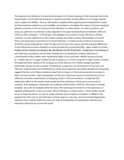| dc.description.abstract | The presence anti-infectives in environmental waters is of interest because of their potential role in the dissemination of anti-infective resistance in bacteria and other harmful effects on non-target species such as algae and shellfish. Since no information on global trends regarding the contamination caused by these bioactive substances is yet available, we decided to investigate the impact of income inequality between countries on the occurrence of anti-infectives in surface waters. In order to perform such study, we gathered concentration values reported in the peer-reviewed literature between 1998 and 2014 and built a database. To fill the gap of knowledge on occurrence of anti-infectives in African countries, we also collected 61 surface water samples from Ghana, Kenya, Mozambique and South Africa, and measured concentrations of 19 anti-infectives. A mixed one-way analysis of covariance (ANCOVA) model, followed by Turkey–Kramer post hoc tests was used to identify potential differences in anti-infective occurrence between countries grouped by income level (high, upper-middle and lower-middle and low income) according to the classification by the World Bank. Comparison of occurrence of anti-infectives according to income level revealed that concentrations of these substances in contaminated surface waters were significantly higher in low and lower–middle income countries (p = 0.0001) but not in upper–middle income countries (p = 0.0515) compared to high-income countries. We explained these results as the consequence of the absence of or limited sewage treatment performed in lower income countries. Furthermore, comparison of concentrations of low cost anti-infectives (sulfonamides and trimethoprim) and the more expensive macrolides between income groups suggest that the cost of these substances may have an impact on their environmental occurrence in lower income countries. Since wastewaters are the most important source of contamination of anti-infectives and other contaminants of emerging concern in the environment, it is expected that deleterious effects to the aquatic biota caused by these substances will be more pronounced in countries with inadequate wastewater and collection infrastructure. With the information currently available, we could not evaluate either the role of the receiving environment or the importance of regulatory frameworks on the occurrence of anti-infectives in surface waters. Future studies should focus on these two factors in order to better evaluate risks to aquatic ecosystems in LM&LICs. We propose that CECs such as anti-infectives could be used as a new class of environmental degradation indicators that could be helpful to assess the state of development of wastewater collection and treatment infrastructure around the world. | en_US |

